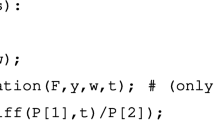Abstract
In this paper, an application of the Riquer-Thomas-Janet theory is described for the problem of transforming a system of partial differential equations into a passive form, i.e., to a special form which contains explicitly both the equations of the initial system and all their nontrivial differential consequences. This special representation of a system markedly facilitates the subsequent integration of the corresponding differential equations. In this paper, the modern approach to the indicated problem is presented. This is the approach adopted in the Knuth-Bendix procedure [13] for critical-pair/completion and then Buchberger's algorithm for completion of polynomial ideal bases [13] (or, alternatively, for the construction of Groebner bases for ideals in a differential operator ring [14]). The algorithm of reduction to the passive form for linear system of partial differential equations and its implementation in the algorithmic language REFAL, as well as the capabilities of the corresponding program, are outlined. Examples illustrating the power and efficiency of the system are presented.
Similar content being viewed by others
References
Ovsyannikov, L. V.: Group Analysis of Differential Equations, Nauka, Moscow, 1978 (Russian).
Ibragimov, N. Kh.: Transformation Groups in Mathematical Physics, Nauka, Moscow, 1983 (Russian).
Schutz, B.: Geometrical Methods of Mathematical Physics, Cambridge University Press, 1982.
Finikov, S. P.: Cartan's exterior calculus, Msk., Leningrad, 1948 (Russian).
Riquer, C.: Les systèmes d'equations aux dérivées partielles, Guthier-Villars, Paris, 1910. 040
Thomas, J., Differential Systems, AMS, Colloquium publications, v. 21, N.Y., 1937.
Janet, M.: Lecons sur les systèmes d'equations aux dérivées, Guthier-Villars, Paris, 1929. 040
Schwarz, F.: Computing 34 (1985), 91.
Gragert, P., Kersten, P., and Martini, R.: Acta Appl. Math. 1 (1983), 43.
Edelen, D. G. B.: Isovector Methods for Equations of Balance, Sijthoff and Nordhoff, 1980; Edelen, D. G. B.: Comp. Math. Appl. 6 (1980), 415.
Kersten, P.: Infinitesimal symmetries and conserved currents for nonlinear Dirac equations, Memorandum 398, Twente Univ. of Technology, 1982.
Kostyukova, N. I.: Sbornik vych. mach. i vych. tech., Vyp. 3, Kharkov: FTINT AN Ukr. SSR, p. 38 (Russian).
Buchberger, B., Collins, G., and Loos, R. (eds.): Computer Algebra, 2nd edn, Springer, 1983.
Buchberger, B.: ACM SIGSAM Bull. 10 (1976), #3, p. 19, #4, p 19.
Pankrat'ev, E. W.: Computations in differential and difference modules, Acta Appl. Math. 16 (1989), 167–189.
Author information
Authors and Affiliations
Rights and permissions
About this article
Cite this article
Topunov, V.L. Reducing systems of linear differential equations to a passive form. Acta Appl Math 16, 191–206 (1989). https://doi.org/10.1007/BF00046572
Received:
Issue Date:
DOI: https://doi.org/10.1007/BF00046572



